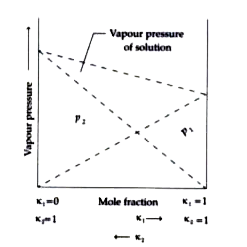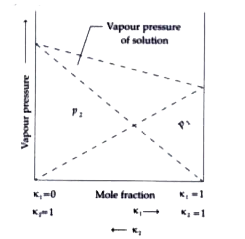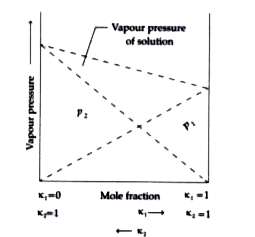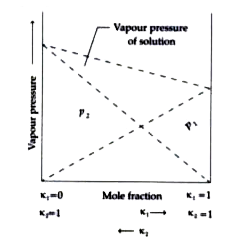How is the mole fraction of a gaseous component related to its partial pressure and the total vapour pressure?
To understand the relationship between the mole fraction of a gaseous component, its partial pressure, and the total vapor pressure, we can break it down step by step.
1. Understanding Partial Pressure:
- The total pressure of a gas mixture is the sum of the partial pressures of each individual gas in the mixture.
- Mathematically, this can be expressed as:
Ptotal=PA+PB+PC
where PA, PB, and PC are the partial pressures of gases A, B, and C respectively.
2. Defining Mole Fraction:
- The mole fraction of a gas is defined as the ratio of the number of moles of that gas to the total number of moles of all gases in the mixture.
- For gas A, the mole fraction (XA) can be expressed as:
XA=nAnA+nB+nC
where nA, nB, and nC are the number of moles of gases A, B, and C respectively.
3. Relating Partial Pressure to Mole Fraction:
- The partial pressure of a gas can also be expressed in terms of its mole fraction and the total pressure.
- For gas A, this relationship can be written as:
PA=XA⋅Ptotal
- Similarly, for gases B and C:
PB=XB⋅Ptotal
PC=XC⋅Ptotal
4. Conclusion:
- From the above relationships, we can conclude that the mole fraction of a gaseous component is directly proportional to its partial pressure and the total vapor pressure.
- This means that if you know the mole fraction of a gas in a mixture, you can find its partial pressure by multiplying the mole fraction by the total pressure.
Final Relationships:
- PA=XA⋅Ptotal
- PB=XB⋅Ptotal
- PC=XC⋅Ptotal
- The total pressure of a gas mixture is the sum of the partial pressures of each individual gas in the mixture.
- Mathematically, this can be expressed as:
Ptotal=PA+PB+PC
where PA, PB, and PC are the partial pressures of gases A, B, and C respectively.
- The mole fraction of a gas is defined as the ratio of the number of moles of that gas to the total number of moles of all gases in the mixture.
- For gas A, the mole fraction (XA) can be expressed as:
XA=nAnA+nB+nC
where nA, nB, and nC are the number of moles of gases A, B, and C respectively.
- The partial pressure of a gas can also be expressed in terms of its mole fraction and the total pressure.
- For gas A, this relationship can be written as:
PA=XA⋅Ptotal
- Similarly, for gases B and C:
PB=XB⋅Ptotal
PC=XC⋅Ptotal
- From the above relationships, we can conclude that the mole fraction of a gaseous component is directly proportional to its partial pressure and the total vapor pressure.
- This means that if you know the mole fraction of a gas in a mixture, you can find its partial pressure by multiplying the mole fraction by the total pressure.
- PA=XA⋅Ptotal
- PB=XB⋅Ptotal
- PC=XC⋅Ptotal
Topper's Solved these Questions
- STATES OF MATTER : GASES AND LIQUIDSBOOK - MODERN PUBLICATIONCHAPTER - STATES OF MATTER : GASES AND LIQUIDSEXERCISE - Conceptual Questions (2)
20 Videos
- STATES OF MATTER : GASES AND LIQUIDSBOOK - MODERN PUBLICATIONCHAPTER - STATES OF MATTER : GASES AND LIQUIDSEXERCISE - NCERT FILE (NCERT)(Textbook Exercises)
23 Videos
- STATES OF MATTER : GASES AND LIQUIDSBOOK - MODERN PUBLICATIONCHAPTER - STATES OF MATTER : GASES AND LIQUIDSEXERCISE - Advanced Level (PROBLEMS)
14 Videos
- SOME BASIC CONCEPTS OF CHEMISTRY BOOK - MODERN PUBLICATIONCHAPTER - SOME BASIC CONCEPTS OF CHEMISTRY EXERCISE - COMPETITION FILE (INTEGER TYPE AND NUMERICAL VALUE TYPE QUESTIONS)
10 Videos
- STRUCTURE OF ATOMBOOK - MODERN PUBLICATIONCHAPTER - STRUCTURE OF ATOMEXERCISE - Unit Practice Test
13 Videos
Similar Questions
What is the relation between the activity of a gaseous component and its partial pressure ?
View SolutionVapor pressure of a solution of Volatile components and composition of vapor: Consider a solution containing 738g of water and 253g of ethanol (C2H5OH) at 323K. At this temperature, the vapour pressure of pure ethanol is 0.292atm and the vapor pressure of pure water is 0.122atm. Calculate the vapour pressure of the solution and mole fraction of every component in vapour phase.
Strategy: First calculate the moles and the mole fraction of each component in the liquid solution. Then apply Raoult's law to each of the two volatile components to calculate their partial pressures. The total vapour pressure is the sum of the partial vapour pressures of the components and the mole fraction of a components in a gaseous mixture equals the ratio of its partial pressure to the total pressure.
View Solution
Knowledge Check
P→tal=x1p∘1+x2p∘2
=p_1^@ + (p_2^@ - p_1^@) x_2'
I. Total vapour pressure of the solution is related to the mole fraction of any one component.
II. Total vapour pressure of the solution varies exponentially with the mole fraction of component 2.
III. Depending on the vapour pressure of pure components 1 and 2, total vapour pressure over the solution decreases or increases with the increase of the mole fraction of component 1.
select the correct staements derived from the equation.AI and IIBII and IIICIII and IDAll of the aboveRead the passage given below and answer the following questions :
Raoult's law states that for a solution of volatile liquids, the partial vapour pressure of each component of the solution is directly proportional to its mole fraction present in solution. Dalton's law of partial pressure states that the total pressure Ptotal over the solution phase in the container will be the sum of the partial pressures of the components of the solution and is given as:
Ptotal= P1+ P2

What type of deviation from Raoult's law does the above graph represent ?AFirst positive then negativeBNegative deviationCPositive deviationDFirst negative then positiveRead the passage given below and answer the following questions :
Raoult's law states that for a solution of volatile liquids, the partial vapour pressure of each component of the solution is directly proportional to its mole fraction present in solution. Dalton's law of partial pressure states that the total pressure Ptotal over the solution phase in the container will be the sum of the partial pressures of the components of the solution and is given as:
Ptotal= P1+ P2

Which of the following aqueous solutions should have the highest boiling point ?A1.0 M NaOHB1.0 M Na2S04C1.0 M NH4NO3D1.0 M KNO3
How is the pressure of a gas in a mixture related to the total pressure of the mixture?
View SolutionHow is boiling point related to the vapour pressure of the liquid?
View SolutionA vessel contains methane and oxygen in the mass ratio of 2:1 .The fraction of partial pressure of oxygen in the total pressure is
View SolutionRead the passage given below and answer the following questions :
Raoult's law states that for a solution of volatile liquids, the partial vapour pressure of each component of the solution is directly proportional to its mole fraction present in solution. Dalton's law of partial pressure states that the total pressure Ptotal over the solution phase in the container will be the sum of the partial pressures of the components of the solution and is given as:
Ptotal= P1+ P2

In comparison to a 0.01 M solution of glucose, the depression in freezing point of a 0.01 M MgCl2 solution is _ ___
View SolutionRead the passage given below and answer the following questions :
Raoult's law states that for a solution of volatile liquids, the partial vapour pressure of each component of the solution is directly proportional to its mole fraction present in solution. Dalton's law of partial pressure states that the total pressure Ptotal over the solution phase in the container will be the sum of the partial pressures of the components of the solution and is given as:
Ptotal= P1+ P2

A solution of two liquids boils at a temperature more than the boiling point of either of them. What type of deviation will be shown by the solution formed in terms of Raoult' s law ?
View Solution
